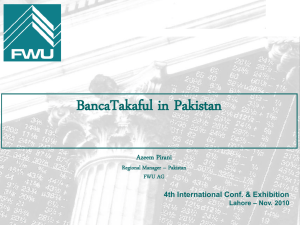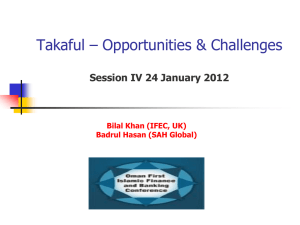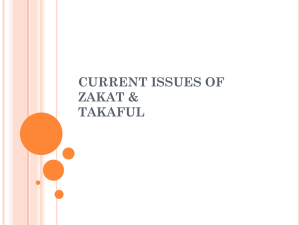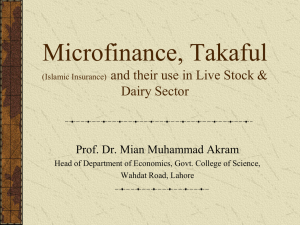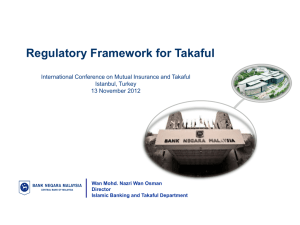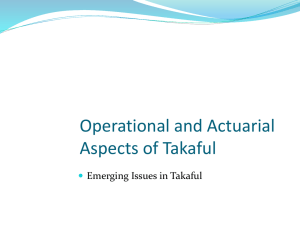OPERATIONAL AND ACTUARIAL ASPECTS OF TAKAFUL
advertisement
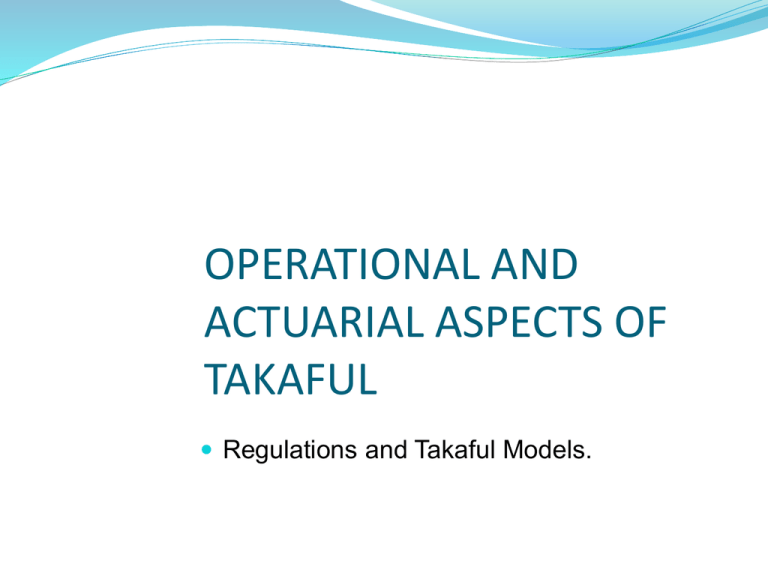
OPERATIONAL AND ACTUARIAL ASPECTS OF TAKAFUL Regulations and Takaful Models. Shariah Basis for Protection and Guarantee Insurance is aim at providing protection from future unforeseen constraints upon the occurrence of an unexpected particular future risk The following sayings by the Holy Prophet justified the concept of protection for those who are in need. “Narrated by Abu Huraira (r.a.. the Holy Prophet(s.a.w.) said: whosoever removes a wordly hardship from a believer, Allah (s.w.t.) will remove from him one of the hardships of the day of judgement. Whosoever alleviates from one, Allah(s.w.t.) will alleviate his lot in this world and the next." Shariah Basis for Protection and Guarantee One should strive hard in overcoming one’s unexpected future risk or perils before leaving one’s destiny in the hand of Allah(s.w.t.) “Anas bin Malik r.a. narrated that the Holy Prophet (s.a.w) told a Bedwin Arab who left his camel untied trusting to the will of Alah (s.w.t.) to tie the camel first then leave it to Allah (s.w.t.) Takaful is not simply a Name Change No Riba Islamic trade and finance thrived in the 7th to 16th century guided by the principles propagated by Islam The current revival of Islamic Finance necessitates the construction of a full set of acceptable financial instruments No Gharar Its implementation in accordance to Shariah principles No Maysir Prohibition of Riba “ ..Allah (s.w.t) permitted trade while prohibited Riba.” (Al- Baqarah 2:275) “…Allah (s.w.t) those who believe, deal not in usury, doubling and quadrupling the sum lent. Fear Allah, and you would be successful (Al-Imran 3:130) Narrated by Abu Huraira (r.a.) “The Holy Prophet said: “if a person conducts two transactions contained in one, he should stick to the lower one or he will commit an act involving riba” Prohibition of Gharar The Holy Quran has explicitly forbidden all business transactions including injustice in any form to any of the parties, whether in the form of deceit or fraud or undue advantage or peril leading to uncertainty in the business or any dealing. (Quran: 6:151-152). Hadith of the Prophet as narrated by Anas bin Malik states that the Prophet forbade the sale of fruits till they were almost ripe. Prohibition of Maisir “ O you who believe! Intoxicants, gambling, idolatrous practices and soothsaying are abomination of Satan’s handiwork. So avoid it in order that you may be successful.” Surah al-Maidah (5:90) Concepts of Takaful 1. 2. 3. The contract of Takaful is founded on the following three principles: Mutual responsibility, Mutual assistance and cooperation, Mutual protection or guarantee. Takaful Act 1984 (TA 1984) Enacted in 1984 and currently under review Follows closely the Insurance Act (amended in 1996) Main Provisions under TA 1984 Section 4 – Requirements for carrying on biz as a Takaful operator Section 8(5) – Registration of takaful operators by the DG (must be Shariah compliant and establish an SAC) Section 11(a);(g);(h)- Cancellation of Registration if not Shariah Compliant; carrying on biz detrimental to the interest of participants ; not able to meet it’s obligations. Section 16- Establishment and maintenance of takaful funds, and allocation of surplus Section 17-Requirements as to Assets of the Takaful Fund Main Provisions under TA 1984 Section 21- Establishment and maintenance of Takaful Guarantee Scheme Fund Section 23 – Re takaful Section 25- Assumption of risks (on General Biz) Section 35- Takaful agents and brokers Section 36 – Intermediaries in takaful transactions Section 42-Actuarial investigation and reports Main Provisions under TA 1984 Section 46 - Investigations of affairs of Takaful Operator Section 47 – Powers of the Director General to issue directions (Guidelines) Section 53A - Advice of the Shariah Advisory Council Section 60 – General provisions to offences Section 66 – Knowledge or statements of agents is deemed that of operator BNM Guidelines (Sec 47) Guidelines on Directorship for Takaful Operators Guidelines on the Governance of Shariah Committee Guidelines on Prohibitions Against Unfair Practices in Takaful Business Guidelines on Proper Advice Practice for Family Takaful Business Guidelines on Operating Costs of Family Takaful Business Guidelines on Financial Statements for Takaful Operators Guidelines on Related Party Transactions for Takaful Operators BNM Guidelines (Sec 47) Guidelines on Outsourcing For Takaful Operators (Investments, IT etc…) Guidelines on Role of Appointed Actuary Guidelines on Financial Condition Report (FCR) Guidelines on Min Standards and Disclosure for Health Takaful Guidelines on Family Takaful Products Main AAOIFI Standards FAS 12- General Presentation and Disclosure in Financial Statements of Islamic Insurance Companies FAS 13- Disclosure of Bases for Determining and Allocating Surplus in Islamic Insurance Companies FAS 14- Investment Funds FAS15- Provisions and Reserves in Islamic Insurance Companies FAS 17- Investments FAS 19- Contributions in Islamic Insurance Companies Main AAOIFI Standards GSIFI 1- Shariah Supervisory Board:Appointment, Composition and Report GSIFI 2- Shariah review GSIFI 3- Internal Shariah Review GSIFI 4- Audit& Governance Committee for Islamic FIs GSIFI 5- Independence of the Shariah Board GSIFI 6- Statement on Governance Principles for Islamic FIs Code of Ethics for the Employees of Islamic FIs Shariah Advisory Council Roles and Functions To advise the Board on Shariah matters in its business operation; To endorse Shariah Compliance Manuals; To endorse and validate relevant documentations; To assist related parties on Shariah matters for advice upon request; To advise on matters to be referred to the SAC; To provide written Shariah opinion; To assist the NSAC on reference for advice; Contract/Models in Takaful The contract defines issues such as: Who pays for the expenses incurred in the business venture How profits are shared between the parties in the agreement Who are liable for any losses arising from the venture Potential Models Potential Models Include: Cooperative Wakala Mudharaba Modified Mudharaba Wakala Mudharaba Wakala with incentive compensation Potential Models The Takaful Model would need to satisfy: Shariah Concerns Technical Concerns Regulatory Concerns Cooperative Model Participant Contribution (Premium) 100% Investment Profit Participants Account (Personal) Investment Profit Operator 100% Policy Benefits Participants Special Account (Common) Actual Management Expenses Underwriting Surplus Mudharabah Model Participant Contribution (Premium) (1 – x)% Investment Profit Participant Account (Personal) Investment Profit Policy Benefits Participants Special Account (Common) x% Operator 100% Actual Management Expenses Underwriting Surplus Wakalah Model Participant 100% Contribution (Premium) Wakalah Fee (to operator) Investment Profit Participants Account (Personal) Investment Profit Actual Management Expenses Operator 100% Policy Benefits Participants Special Account (Common) Underwriting Surplus Waqf Model Participant 100% Contribution (Premium) Wakalah Fee (to operator) Investment Profit Policy Benefits Participants Account (Personal) Waqf Fund Investment Profit Actual Management Expenses Operator 100% Underwriting Surplus Modified Mudharaba Model Participant Contribution (Premium) (1x)% Investment Profit Participants Account (Personal) Investment Profit Participants Special Account (Common) (1y)% Policy Benefits Underwriting Surplus x% Operator Actual Manageme nt Expenses y% Wakala Mudharaba Model Participant Wakala Fee (to 0perator) (1-x)% Investment Profit Contribution (Premium) Participants Account (Personal) Investment Profit x% Operator Mercer Participants Special Account (Common) 100% Policy Benefits Underwriting Surplus Wakala with Incentive Compensation Participant Wakala Fee (to operator) (1-x)% Investment Profit Contribution (Premium) Participants Account (Personal) Investment Profit Participants Special Account (Common) (1-y)% Policy Benefits Underwriting Surplus x% y% Operator Mercer Potential Models Models which may be of concern to some Shariah councils: Modified Mudharaba Wakala with Incentive Compensation These models allow the Operator to share in underwriting surplus which may not be allowed Mercer Potential Models Takaful Models which would be of concern to Actuaries: Cooperative Mudharaba Insufficient income to the Operator generally results from these models, as well as difficulties matching income and outgo Potential Models There may also be restrictions on the model which can be used due to regulatory constraints. This would vary by country. Bank Negara currently favors the wakala mudharaba and wakala with incentive compensation models Potential Models Takaful Models which should be universally acceptable worldwide from a technical and shariah point of view: Wakala Wakala with a Mudharaba in investments profit Simplified Profit and Loss – Pure Wakalah Example :Conventional Insurance Shareholders’ Fund + Investment Income - Expenses Life Fund (Par) + Premium + Investment Income Claims Commissions Management Expenses Takaful Operator’s Fund + Investment Income + Wakalah Fees Commissions Management Expenses Takaful Fund + Contribution + Investment Income - Wakalah Fees - Claims Reserves Profit/Loss Reserves Surplus/Deficit Profit/Loss Surplus shared by both Shareholders and Policyholders. Formula for allocation fixed by regulators Surplus/Deficit Surplus NOT shared with Operator Sources of Income – Pure Wakalah Takaful Operator’s Fund + Investment Income + Wakalah Fees Commissions Management Expenses Takaful Fund + Contribution + Investment Income - Wakalah Fees - Claims Participant Account (Saving) + Contribution + Investment Income - Tabarru Risk Fund + Investment Income + Tabarru - Claims Reserves Profit/Loss Surplus/Deficit Reserves Surplus NOT shared with Operator Surplus Surplus/Deficit Simplified Profit and Loss (for illustration only) This is not an indication of the profitability of an insurance company against a takaful operator. Conventional Insurance Surplus shared by both Shareholders and Policyholders. Formula for allocation fixed by regulators Takaful Surplus NOT shared with Operator Risk Management via Technical Design In terms of the technical design of the Takaful model: With risks come rewards, no risks mean no rewards The key to success is to understand exactly what risks are being taken and manage them appropriately There is much more diversity in the risks taken by the various Takaful operators compared to conventional insurers and other Islamic Financial Services Risk Management via Technical Design(…contd) Certain risks will be present irrespective of model chosen: Expenses risks Investment risks Underwriting risks Shariah risks Regulatory risks Market risks Risks Associated with Model Possible risks: Investment A Wakala model can be designed with incentive compensation for good investment returns A Wakala model with charges as a percentage of Net Asset Value (NAV) also has investment risk A pure Mudharaba(on Investments) model hinges on iinvestments income to succeed A modified Mudharaba model also contains investment risk Thus differing levels of investment risk can be taken, with corresponding levels of rewards expected Risks Associated with Model Design Mortality / Benefit Risk: All models have some level of underwriting risk, as if experience is poor enough a Qardl Hasan loan will be given by the operator A Wakala model can be structured to share in underwriting surplus, thus increasing mortality/benefit risk A modified Mudharaba model generally has significant mortality/benefit risk Risks Associated with Model Design Expense Risk: For most models management expenses and commission are paid from the operators fund. Thus expense risk is significant In some models expenses are paid from the risk fund, thus passing this risk back to the participants Risks Associated with Model Design Distribution Risks A complicated model might have excellent risk reduction features/be technically pleasing, but if it is too complicated for the distribution force to understand then sales will be affected Similarly the model can be designed such that the products look very similar to conventional products or distinctly different depending on the needs of the distribution force Risk Management via Technical Design(…contd) Insurers may vary risk exposures via the products sold: Mortality risk may be the focus for insurers promoting mortgage reducing term plans Investment risk may be the focus for insurers promoting participating products Expense risk may be the focus for insurers promoting unit linked plans Risk Management via Technical Design(…contd) Medical and health risk may be the focus for insurers selling health plans and yearly renewable riders Hence, Takaful Operators may focus on these risks and diversify via product development similar to conventional insurers, but may also address risk via the Takaful model chosen HLTMT Business Model Participant Contribution surrender payment (less maturity charges), expiring payment. benefit payment (Death/TPD Benefit) Participants’ Fund Wakalah Fees Monthly Walah Monthly Tabarru’ Yearly Investment Profit (Mudharabah Basis) Special Reserve Fund Risk Fund Operator’s Fund *Annual Allocation Yearly Surplus Note : * Subject to the recommendation by the Appointed Actuary Actual Management Expenses Qardhul Hasan Loan (if necessary) How is it different from Conventional Insurance The Issues Conventional Insurance Takaful Regulations Insurance Act 1996, BNM GPI and LIAM regulations Takaful Act 1984, BNM JPIT and MTA regulations Shariah Standards may follow BNM SAC and AAOFII Governance Structure Board of Directors representing shareholders. Audit, Risk Mgt, Nomination and Renumeration is required under GPI 1 Board of Directors representing shareholders and SAC.SAC is required by the Act. Audit, Risk Mgt, Nomination and Renumeration is required under JPIT 1 Risk Management Underwriting of risks. Invariably uses Reinsurance If strictly. Operator just manage the risks and the investment fund. To mitigate larger risk exposure Retakaful is given priority. Doctorine of neccessity can allow Reinsurance. Nature of Contract Risk is tranfered to Insurer through Participation in Risk Pool by a Buy and Sell contract making Tabarru’ . Gharar must be minimal How is it different from Conventional Insurance The Issues Conventional Insurance Takaful The “black box” The policyholder does not know how his premium is utilised, i,e, how much goes for expenses , how much goes to profit of the insurer and how much to pay claims. In accordance to the requirement to avoid gharar, the Takaful contract clearly sets out what is for expenses and profit and what is used to pay claims. The investment Insurance companies usually invest in riba earning instruments and in companies involved in forbidden businesses. The benefits In some cases the policyholder makes a windfall as result of being eligible to claim under a policy. This has elements of gambling (maysir) No Riba investments and investments only made in accepted businesses (significant overlap with Socially Responsible Investments). Strictly a contract of Indemnity. The participant may or may not claim under a Takaful contract. Profitability Sources include experience gains,investment gains and expense margins. Strictly, sources should be from wakalah fees, and profit sharing of investment returns The End
